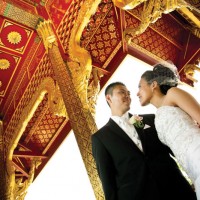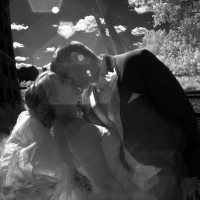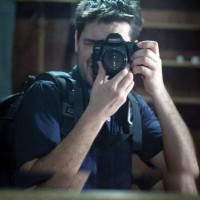From the trenches: Wedding photography can be fun – and frustrating
- Details
- Published on Tuesday, 01 January 2013 13:00
- Written by Bill Knight
Weddings are about gowns and flowers, rings and receptions, honeymoons and memories, and helping make the memories last is the job of wedding photographers.
It’s a fun and frustrating, tense and tender task, according to two Peoria-area photographers, one a 45-year-old now out of the business and the other a 29-year-old still busy with brides, portraits and more.
Often, the most memorable moments are unplanned, says Christopher Cote.
“After the ceremony, one bride and groom suddenly decided to go to the hospital to visit her grandma, who’d been diagnosed with cancer. I said, ‘Do you want me to go with you’ and it was really special. There wasn’t a dry eye in the room. A couple of weeks later she passed and it turns out those photos were the family’s last pictures of Grandma. So that hit home. You never know; you take it seriously,” he said.
Cote learned photography fundamentals as a teen, tutored by his parents, Greg and Melinda Cote of Edwards. He started as a professional after a girlfriend referred him to an opening at a studio, where he was mentored on the job, and now does weddings in central and northern Illinois, Chicago and mostly Milwaukee, where he’s based.
Don Wagner also got interested in photography as a kid and worked as a wedding photographer for more than 20 years, starting in the late 1980s. It was a long career compared to most, he says.
“The ‘life expectancy’ of a wedding photographer is about seven years,” says Wagner, who mostly worked in Chicago but left the business in 2010 to become a Princeville land broker (who still does nature and wildlife photography).
“That seven years is pretty well known in the industry – unless maybe you have a degree in psychology to be able to deal with the stress of handling people,” he continues.
For example, there are unexpected surprises, shocking as well as charming.
“At one wedding I shot, after the ceremony – during the first dance – the bride took off her ring, threw it at the groom and left,” Wagner says. “For a second, everyone at the reception thought it was staged or something,
but she never came back. They broke up.” Photographers see it all, he adds.
“The best part is meeting engaging personalities, strangers you might relate to immediately, who are easy to work with and appreciative of what you’re doing,” Wagner says. “It sometimes seemed easy and fun; little kids are always adorable. The worst is someone who, no matter what, won’t be happy. And, of course, there’s alcohol involved, so things can run wild.”
Commercially, things got wild after the change from film and darkrooms to computers and smart cameras – an unwinnable challenge, Wagner says.
“Technology was good for the quality, but it really hurt the industry,” he says. “When digital took over, everybody I knew had to cut back. We shot large format and fees were $2,000 to $3,000. Suddenly, ‘cheap and OK’ became preferable to ‘expensive and great’.
“We were undercut by amateurs – ‘weekend warriors’ – who took some snapshots and gave the bride a disc and they were done,” Wagner continues. “No enhancing, no color-correcting, no albums. So later, a disc is damaged or a computer crashes and everything’s lost.”
The images aren’t all that can be lost in the emotional tornado that weddings can be, Cote says.
“Too many couples don’t understand that weddings are about love and fun, not obsessing that the flowers are the wrong color or throwing a fit that something’s 10 minutes late,” Cote says. “At the end of the day, you get rings and see your loved ones and you don’t want to lose all that with details.
“There have been a few instances,” he adds, laughing. “One bride got drunk and stood on a bar and starting taking off her dress. Another time I had to call police to break up a brawl in the parking lot at a reception. I just learned to laugh it off – and hope that stuff doesn’t happen at my wedding someday.”
Photographers take different approaches in their work. Some stay in the background; other go for a more accessible presence. Either can lead to uncomfortable moments.
“Sometimes someone in the bridal party sees a guy with an eyebrow ring shooting photos and thinks, ‘Hey, he’d like to do some shots or weed,’ so that’s awkward,” Cote says, laughing. “But at least they see me as being part of the group.”
Wagner recalls one wedding where his low-key style was punished.
“It can be frustrating,” he says. “One over-the-top bride was trying to micromanage every little detail and for some reason didn’t see me during the actual ceremony, and somehow she concluded I’d just gone to lunch or something. In a while I realized she was stewing and her husband was obviously ticked off and the family sort of treated me weird, and I wondered what was going on. A couple of days later, she called the studio and screamed and threatened to sue because I wasn’t at the ceremony – but I had the photos! I’d been there all along. They picked up their album and didn’t even apologize.” Still, there are rewards, both add.
“Wedding photography was a terrific way to be creative and make a living,” Wagner says, “and it’s great for a single guy. That’s how I met my wife, Kim.”
Cote says he tries to keep it all in perspective.
“Any time the bride and the groom are satisfied and you get a hug or whatever, that feels good,” Cote says.
Christopher Cote
Don Wagner






















































